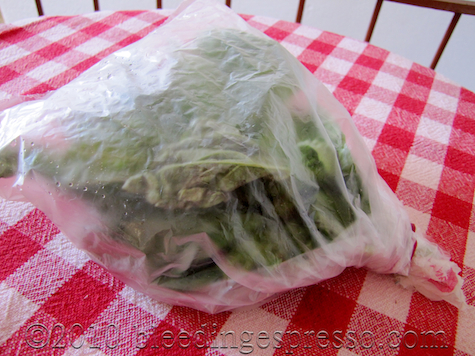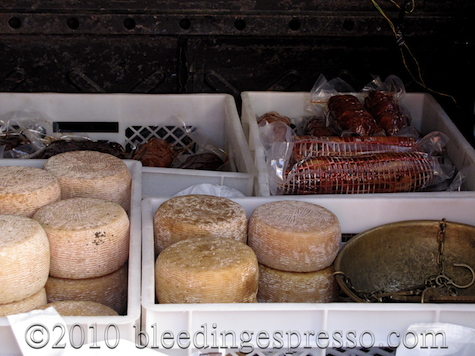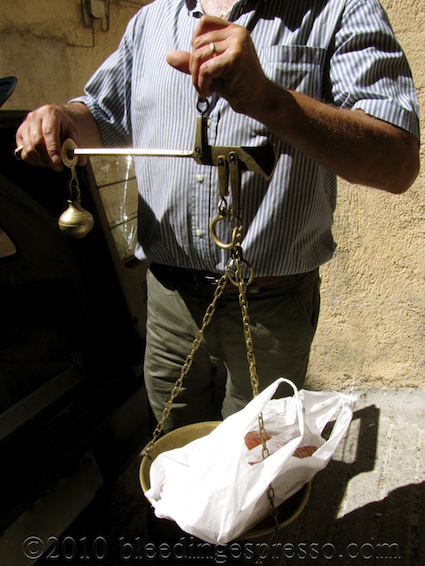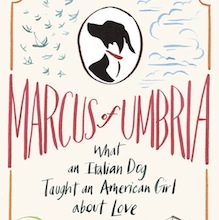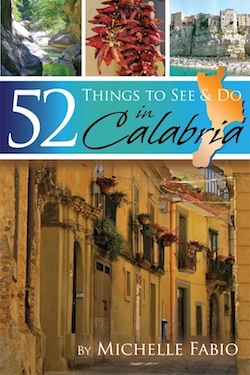Archive for 2010
How to Store Fresh Cut Basil
As we’re at the height of basil season here, I thought I’d share with you my method for how to keep basil fresh after it has been cut from the plant.
I’ve tried all kinds of ways over the years, and this is what I have found works best:
1. Wrap the stems in a damp paper towel.
2. Put a plastic bag over the unwashed leaves and secure with a rubber band at the base.
3. Place the basil in the refrigerator.
4. Pluck off leaves as you need them, washing just before use.
With this method, I have kept basil fresh for up to two weeks in the refrigerator, but you do want to keep an eye on it if you’re not using it immediately. Be sure to re-wet the paper towel when it’s going dry and also remove any leaves that are turning black and/or slimy; they will get moldy if left in there too long.
If you still aren’t using your basil quickly enough before it goes off, wash and pat dry the basil then tear off the leaves and pop them in a freezer bag. The leaves won’t be great for something like a Caprese Salad once they’re thawed, but they’ll still add great basil taste to soups and dishes like our Borlotti Beans alla Calabrese — and they do retain excellent flavor for about four to six months.
What are your favorite food storage tips?
Impariamo l’Italiano con l’Aiuto della Mano! by Giuliana Sica
Impariamo l’Italiano is eye-catching, informative, engaging, and the illustrations are downright adorable.
Read on...The Eye on Italy Podcast
 If you follow me on Twitter or Facebook, you have probably already heard about the Eye on Italy podcast (but please make sure to read through the post for updated info!). For those of you who haven’t, here’s your official introduction:
If you follow me on Twitter or Facebook, you have probably already heard about the Eye on Italy podcast (but please make sure to read through the post for updated info!). For those of you who haven’t, here’s your official introduction:
Eye on Italy is “[a] podcast for anyone who’s loved Italy or wants to love it.” Each week, Jessica Spiegel (WhyGo Italy), Sara Rosso (Ms Adventures in Italy), and I talk about current events and other interesting topics that relate to the Bel Paese.
We have been privileged to host some rather awesome guests so far, including Gelato King David Lebovitz; B&B owner and creative soul Diana Baur; and art historian, sommelier, and food expert Katie Parla. We’ve tackled all kinds of issues from the freedom of the press in Italy with Livia Iacolare, community coordinator and assistant producer of Italy’s Current TV, to uncovering the Holy Foreskin with author David Farley.
There are already 14 podcasts available for your listening pleasure, but there’s no need to feel behind! Now that we’re taking a little August break like the rest of Italy, you have plenty of time to catch up on what you’ve been missing so far. You can subscribe on our page or directly at iTunes.
And for those of you who have been following, first thank you! Second (and this goes for everyone) keep an eye (hah!) on the Eye on Italy website for posts throughout August as we’ll be sharing links to some of the news stories and blog posts that have caught our attention . . . starting today with the spotlight on Art & Culture.
Thanks again to all who have been listening, and as always, if you have feedback, comments, or even guest suggestions, please pass them along either through the website or at the following locations:
- Eye on Italy on Facebook
- @EyeonItaly on Twitter
Happy listening (and reading)!
Calabria Traveling Market: Buying Pecorino, Capocollo, ‘Nduja, and Pancetta from the Back of a Car
In Calabria, some days you go to the market. On other days you’re innocently typing away on your computer when you hear the cry of “Formaggio formaggio formaggio paesanoooo!” outside.
On those days, the market has come to you. So you grab your wallet and camera (no need for keys — you can just leave those in the lock in the front door), and head outside to see your choices.
Here was the selection yesterday morning:
This is all homemade and handmade locally by the seller and his wife.
Here he is weighing my capocollo and pancetta:
Yes, I decided to splurge and get pecorino, capocollo, and pancetta. Paolo and his friends have been working hard in our campagna (which means they need food up there every day) and most of his family is also around this month, so it’s good to have reserves in the house for drop-ins.
Homemade “paesano” salumi and cheese doesn’t come cheap, but it’s worth every centesimo. Still, the guy could sense my reluctance to part with my euros (may have been due to my price-haggling), so he threw in a big chunk of ‘nduja for free. You can see it a bit in the upper left of this photo:
What’s that? You’re not familiar with ‘nduja (ahn-DOO-ya)? Guess I’ll have to write a blog post about it, but for now, suffice it to say that it’s a Calabrian treasure — an uber-spicy, spreadable sausage that works well on everything from bruschetta to pasta.
And if you want a refresher course on the differences between pancetta, capocollo, our beloved suppressata, and more, check out Vince Scordo’s Guide to Cured Italian Meats: Salumi.
How would you enjoy the pecorino and salumi I picked up at the traveling market?
Marcus of Umbria by Justine van der Leun
 Marcus of Umbria: What an Italian Dog Taught an American Girl About Love by Justine van der Leun is about a young American woman who moves to a small, rural village in Italy on a whim and ends up falling in love with a dog.
Marcus of Umbria: What an Italian Dog Taught an American Girl About Love by Justine van der Leun is about a young American woman who moves to a small, rural village in Italy on a whim and ends up falling in love with a dog.
Does it surprise you that I really, really enjoyed this book?
After becoming smitten with a local Italian ragazzo on vacation, the author packs up her New York City life and transplants herself to Collelungo in Umbria, the Green Heart of Italy. She immediately becomes part of the family, and she is expected to contribute as such. I think it’s safe to say this is her first of many culture shocks detailed throughout the book.
As we learn more about Justine’s new surroundings and the people playing prominent roles in her daily life, we also get to know the author through how she handles new, challenging situations. The picture isn’t always pretty, but it certainly seems honest. Being able to trust the author of a memoir is always a huge plus.
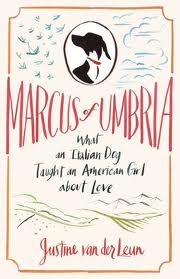 Justine’s time in the village wasn’t full of leisurely days sipping wine under the Umbrian sun and raucous family gatherings by night, and she pulls no punches on this anti-Under the Tuscan Sun lifestyle she adopts. Her fidanzato isn’t the most attentive (although he seems like a good enough guy), his brother has a cruel streak to say the least, and common methods of keeping and training animals are heart-wrenching to animal lovers.
Justine’s time in the village wasn’t full of leisurely days sipping wine under the Umbrian sun and raucous family gatherings by night, and she pulls no punches on this anti-Under the Tuscan Sun lifestyle she adopts. Her fidanzato isn’t the most attentive (although he seems like a good enough guy), his brother has a cruel streak to say the least, and common methods of keeping and training animals are heart-wrenching to animal lovers.
Justine manages to present these tidbits and others in a very matter-of-fact way though, without judgment. It is what it is, if you will, and in many instances, it’s been that way for centuries in Collelungo (and other small towns throughout Italy). I can’t speak for what the people of Collelungo might think about Justine’s perceptions as related in the book, but from my perspective in what seems to be a similar village, they rang fairly accurate.
But through all the ups and downs of life in Collelungo, Justine’s growing love for Marcus, an English pointer she rescues, keeps her grounded — in fact, literally, as she is reluctant to leave town even after her love affair has soured, not knowing what will happen to her beloved pooch. Indeed, the only issue I had with the book is that I would have liked more Marcus!
Witty, descriptive, well-crafted, and just plain entertaining, this book gets four and a half espresso cups out of five; more Marcus would’ve had my cup runneth-ing over. Marcus of Umbria is more about Justine’s year living in rural Italy than simply a girl meets dog tale, but what it does, it does well — so I highly recommend it.
P.S. You can also “like” Marcus of Umbria on Facebook and follow Justine @justinevdl on Twitter.
*
Subscribe to my Book Reviews feed — book reviews ONLY, which aren’t published to the main feed — by visiting Feedburner.

